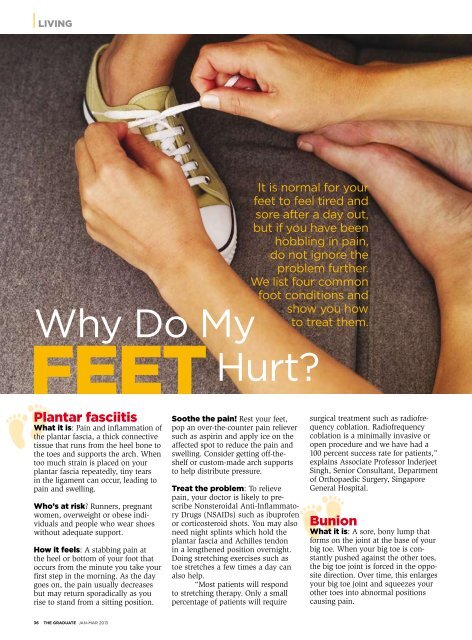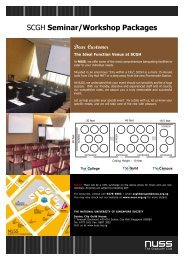The view from singapore with British High Commissioner to ... - NUSS
The view from singapore with British High Commissioner to ... - NUSS
The view from singapore with British High Commissioner to ... - NUSS
You also want an ePaper? Increase the reach of your titles
YUMPU automatically turns print PDFs into web optimized ePapers that Google loves.
living<br />
It is normal for your<br />
feet <strong>to</strong> feel tired and<br />
sore after a day out,<br />
but if you have been<br />
hobbling in pain,<br />
do not ignore the<br />
problem further.<br />
We list four common<br />
foot conditions and<br />
show you how<br />
<strong>to</strong> treat them.<br />
Why Do My<br />
Hurt?<br />
FeetSoothe the pain! Rest your feet,<br />
Plantar fasciitis<br />
What it is: Pain and inflammation of<br />
the plantar fascia, a thick connective<br />
tissue that runs <strong>from</strong> the heel bone <strong>to</strong><br />
the <strong>to</strong>es and supports the arch. When<br />
<strong>to</strong>o much strain is placed on your<br />
plantar fascia repeatedly, tiny tears<br />
in the ligament can occur, leading <strong>to</strong><br />
pain and swelling.<br />
Who’s at risk? Runners, pregnant<br />
women, overweight or obese individuals<br />
and people who wear shoes<br />
<strong>with</strong>out adequate support.<br />
How it feels: A stabbing pain at<br />
the heel or bot<strong>to</strong>m of your foot that<br />
occurs <strong>from</strong> the minute you take your<br />
first step in the morning. As the day<br />
goes on, the pain usually decreases<br />
but may return sporadically as you<br />
rise <strong>to</strong> stand <strong>from</strong> a sitting position.<br />
36 THE GRADUATE Jan-Mar 2013<br />
pop an over-the-counter pain reliever<br />
such as aspirin and apply ice on the<br />
affected spot <strong>to</strong> reduce the pain and<br />
swelling. Consider getting off-theshelf<br />
or cus<strong>to</strong>m-made arch supports<br />
<strong>to</strong> help distribute pressure.<br />
treat the problem: To relieve<br />
pain, your doc<strong>to</strong>r is likely <strong>to</strong> prescribe<br />
Nonsteroidal Anti-Inflamma<strong>to</strong>ry<br />
Drugs (NSAIDs) such as ibuprofen<br />
or corticosteroid shots. You may also<br />
need night splints which hold the<br />
plantar fascia and Achilles tendon<br />
in a lengthened position overnight.<br />
Doing stretching exercises such as<br />
<strong>to</strong>e stretches a few times a day can<br />
also help.<br />
“Most patients will respond<br />
<strong>to</strong> stretching therapy. Only a small<br />
percentage of patients will require<br />
surgical treatment such as radiofrequency<br />
coblation. Radiofrequency<br />
coblation is a minimally invasive or<br />
open procedure and we have had a<br />
100 percent success rate for patients,”<br />
explains Associate Professor Inderjeet<br />
Singh, Senior Consultant, Department<br />
of Orthopaedic Surgery, Singapore<br />
General Hospital.<br />
Bunion<br />
What it is: A sore, bony lump that<br />
forms on the joint at the base of your<br />
big <strong>to</strong>e. When your big <strong>to</strong>e is constantly<br />
pushed against the other <strong>to</strong>es,<br />
the big <strong>to</strong>e joint is forced in the opposite<br />
direction. Over time, this enlarges<br />
your big <strong>to</strong>e joint and squeezes your<br />
other <strong>to</strong>es in<strong>to</strong> abnormal positions<br />
causing pain.









